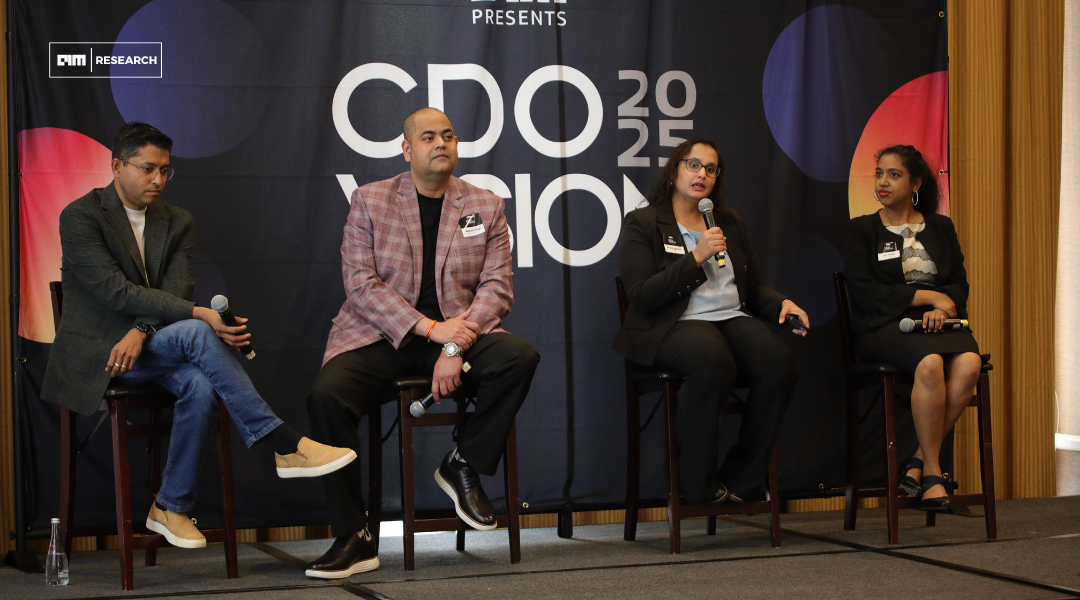
How AI-First Approach Is Redefining Enterprises : Insights From CDO Vision Dallas
- By Upasana Banerjee
- Published on
The AI-first approach involves "integrating AI into the DNA of their business"


The financial services industry stands at a pivotal moment in its digital transformation journey. As artificial intelligence evolves from a support function to the core of business operations, industry leaders are grappling with fundamental questions about implementation, governance, and trust. A recent panel discussion featuring Shuchi Agarwal, CDO of Global Head of Data Tooling Adaption, Automation and Data Provisioning at Citi. Jaya Eripilla, VP Senior Technology Manager, Data Analytics and Insights Technology at Bank of America. Kamlesh Singh, Regional Sales Head at Tiger Analytics. provided valuable insights into what it truly means to be “AI-first” in today’s enterprise landscape.
The concept of being “AI-first” represents a fundamental mindset shift that goes far beyond traditional automation initiatives. Companies have been implementing AI and machine learning for over a decade. However, the AI-first approach involves “integrating AI into the DNA of their business” rather than simply using technology to reduce costs or increase efficiency.
This transformation manifests in tangible ways across customer interactions. Consider a typical customer service call that traditionally takes five to six minutes while agents research account information, relationship histories, and potential solutions. An AI-first approach leverages augmented intelligence to analyze customer data, transaction patterns, life events, and cross-selling opportunities in real-time, reducing call duration to approximately one minute while significantly enhancing the customer experience.
The shift extends to data operations as well. Instead of manual processes for moving data between systems and processors, AI-first organizations deploy intelligent systems that can detect data requirements, timing needs, and accuracy levels automatically. This represents a move from reactive data management to proactive, intelligent data orchestration.
Bank of America’s virtual financial assistant, Erica, serves as a compelling case study for AI-first implementation. Developed in 2016 and launched in 2018, Erica has achieved remarkable adoption rates among the bank’s customer base. With Bank of America serving approximately 69 million consumer and small business accounts, the platform has digitized interactions for 57 million customers, with 47 million actively using Erica.
The success metrics are impressive: Erica now impacts 59 million customers and has delivered nearly nine times return on investment. This ROI stems from two primary sources: efficiency gains through call deflection and relationship deepening through enhanced customer engagement programs like Preferred Rewards.
The technical foundation supporting Erica’s success demonstrates the importance of architectural decisions in AI-first initiatives. Bank of America built a horizontal architecture featuring standardization across applications, single repositories, and common platforms. This infrastructure, combined with large-scale big data capabilities, enables comprehensive customer insights that drive both operational efficiency and revenue growth.
Tiger Analytics’ approach to advising clients on AI-first strategies centers on two fundamental areas beyond basic governance and data infrastructure:
The first pillar involves developing entirely new ways of interacting with customers and generating revenue. Erica exemplifies this approach by opening a new customer interaction channel. Another example involves a Fortune 500 client that integrated natural language processing, generative AI, and computer vision to process multimodal content including videos, PDFs, and documents. This system allows suppliers to upload content for automatic processing and deployment to branded front-ends, creating a new revenue stream while improving supplier engagement.
While the second pillar focuses on autonomous systems that support critical business decisions. These systems employ decision intelligence to monitor real-time events, process massive data volumes, and deliver actionable insights. They assess important issues for companies and stakeholders, providing contextual information and action plans before problems escalate. This proactive approach transforms AI from a reactive tool to a strategic business partner.
In highly regulated industries like financial services, trust forms the cornerstone of successful AI implementation. The stakes are particularly high given the potential reputational damage from incorrect recommendations or biased results stemming from poor data quality.
The foundation of trust begins with data quality. Any AI implementation, whether involving agentic flows or traditional models, must start with reliable, unbiased data. This requirement becomes particularly challenging for large financial institutions with complex, fragmented data landscapes resulting from decades of acquisitions, divestitures, and geographic expansion.
Organizations like Citi, with operations spanning 160 countries and over 200,000 employees, face inherent data consistency challenges. The solution involves implementing comprehensive data governance strategies supported by modern architectures including graph databases, data mesh, and data fabric approaches.
The regulatory environment adds another layer of complexity to AI-first initiatives. Financial institutions must navigate regulations including EU AI Act, GDPR, and CCPA, making explainability not just desirable but mandatory. This requirement extends beyond simple compliance to encompass bias testing, fairness assessments, and comprehensive model validation processes.
Successful implementations incorporate explainability tools such as LIME, SHAP, and IBM’s AI Fairness 360 from the design phase. Additionally, robust data structures must support access controls, logging, and auditability, ensuring complete traceability of who accessed which accounts, when, and what actions were taken.
Trust maintenance requires ongoing vigilance through comprehensive observability frameworks. Organizations cannot simply deploy AI systems and assume they will continue operating safely. The threat landscape continues evolving, with adversarial groups developing sophisticated attacks including ransomware and other malicious activities.
Security must be integrated into the entire AI lifecycle, from data pipelines to deployment processes. This approach requires cross-functional collaboration between security teams, product teams, and engineering teams to ensure holistic threat assessment and mitigation.
Industry leaders anticipate significant developments in AI capabilities over the next few years, with two primary trends emerging:
The first trend involves comprehensive process automation where AI systems gain the capability to make independent decisions across entire workflows. This hyperautomation goes beyond simple task automation to reimagine complete business processes, creating new customer experiences and operational efficiencies.
The second trend focuses on deploying AI capabilities at the edge, enabling real-time processing of massive data volumes and immediate insight generation. This capability will transform how organizations respond to market conditions, customer needs, and operational challenges by eliminating the latency inherent in centralized processing models.
As AI capabilities advance rapidly, organizations face the challenge of maintaining workforce engagement and preventing employee alienation. The pace of change has accelerated from yearly innovations to monthly or even daily developments, creating potential knowledge gaps among staff.
Successful AI-first organizations prioritize AI literacy programs and inclusive innovation approaches that help employees understand and contribute to AI initiatives rather than feeling threatened by them. This balance between innovation and inclusion becomes critical for sustaining long-term organizational transformation.
Governance in Practice: Managing Innovation Responsibly
The balance between innovation and governance requires careful orchestration, particularly in regulated industries. While innovation teams naturally want to move quickly and take calculated risks, regulatory requirements demand thorough vetting of every use case.
Financial institutions typically implement committee-based approval processes involving HR, legal, compliance, and technical review boards. This approach ensures that innovation occurs within acceptable risk parameters while maintaining the ability to compete effectively in the marketplace.
The key lies in creating sandbox environments and innovation labs where teams can experiment freely while maintaining strict controls for production deployments. This dual approach allows organizations to explore AI possibilities without compromising customer safety or regulatory compliance.
The transition to AI-first operations represents more than a technological upgrade; it requires fundamental changes in organizational thinking, culture, and operations. Success depends on treating AI as a business strategy rather than an IT initiative, with careful attention to data quality, regulatory compliance, and workforce development.
Organizations that successfully navigate this transformation will gain significant competitive advantages through enhanced customer experiences, operational efficiencies, and new revenue opportunities. However, those that approach AI implementation without proper governance, trust-building measures, and strategic planning risk significant setbacks in an increasingly AI-driven marketplace.
The financial services industry’s experience with AI-first transformation provides valuable lessons for organizations across sectors. The emphasis on trust, governance, and strategic implementation offers a roadmap for other industries embarking on similar journeys. As AI capabilities continue advancing, the organizations that balance innovation with responsibility will emerge as leaders in the next phase of digital transformation.
📣 Want to advertise in AIM Research? Book here >

Cypher 2024
21-22 Nov 2024, Santa Clara Convention Center, CA
A Vendor Briefing is a research tool for our industry analysts, and an opportunity for a vendor to present its products, services and business strategies to analysts who cover the vendor specifically or a related technology or market.
AIM Research encourages technology vendors and agencies to brief our team for PeMa Quadrants, when introducing a new product, changing a business model, or forming a partnership, merger, or acquisition.


